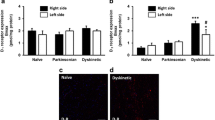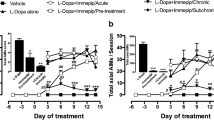Abstract
Neurological side effects associated with neuroleptic drugs result from a complex interaction of multiple neurotransmitters. To clarify the etiology of neuroleptic-induced acute dystonic reactions, monkeys (Cercopithecus aethiops) were treated with haloperidol at doses sufficient to evoke dystonia, and the effects of agents that influenced dopaminergic, cholinergic, or GABAergic neurotransmitters were evaluated. Apomorphine, a dopamine (DA) agonist, and biperiden, an acetylcholine (ACh) antagonist, decreased acute dystonia, whereas α-methyl-p-tyrosine (AMPT), an inhibitor of DA synthesis, and physostigmine, and ACh agonist, increased the symptoms. Muscimol, a GABA agonist, increased the dystonias in a dose-dependent way, and GABA inhibition with picrotoxin also aggravated dystonia, complicated by systemic intoxication and seizures. The reciprocal interaction between DA and ACh influences is consistent with clinical findings and animal models of dyskinesias. Dystonia may also be modulated by GABAergic substrates, but the results suggest complex interactions among DA, ACh, and GABA neurotransmission. Symptoms involving the orofacial, limb, and trunk regions, and purposeless overactivity are discussed in comparison with acute and tardive neuroleptic-induced movement disorders.
Similar content being viewed by others
References
Bedard P, Delean J, Lafleur J, Larochelle J (1977) Haloperidol-induced dyskinesias in the monkey. Can J Neurol Sci 4:197–201
Casey DE, Denney D (1977) Pharmacological characterization of tardive dyskinesia. Psychopharmacology 54:1–8
Casey DE, Gerlach J, Christensson E (1980a) Behavioral aspects of GABA-dopamine interrelationships in the monkey. Brain Res Bull 5 in press
Casey DE, Gerlach J, Magelund G, Rosted Christensen T (1980b) γ-Acetylenic GABA in tardive dyskinesia. Arch Gen Psychiatry in press
Cools AR, Hendriks G, Korten J (1975) The acetylcholine-dopamine balance in the basal ganglia of rhesus monkeys and its role in dynamic, dystonic, dyskinetic, and epileptoid motor activities. J Neural Trans 36:91–105
Egbe PC, Wray SR (1977) Differential attenuation by atropine and d-amphetamine on hyperactivity: Possible clinical implications. Psychopharmacology 54:25–30
Fann WE (1966) Use of methylphenidate to counteract acute dystonic effects of phenothiazines. Am J Psychiatry 122:1293–1294
Gerlach J (1979) Tardive dyskinesia. Dan Med Bull 26:209–245
Gerlach J, Reisby N, Randrup A (1974) Dopaminergic hypersensitivity and cholinergic hypofunction in the pathophysiology of tardive dyskinesia. Psychopharmacologia 34:21–35
Gessa R, Tagliamonte A, Gessa GL (1972II) Blockade by apomorphine of haloperidol-induced dyskinesia in schizophrenic patients. Lancet 981
Gunne LM, Barany S (1976) Haloperidol-induced tardive dyskinesia in monkeys. Psychopharmacology 50:237–240
Magelund G, Gerlach J, Casey DE (1979) Neuroleptic-potentiating effect of α-methyl-p-tyrosine compared with haloperidol and placebo in a double-blind crossover trial. Acta Psychiat Scand. 544:1–5
Marsden CD, Tarsy D, Baldessarini RJ (1975) Spontaneous and drug-induced movement disorders in psychotic patients. In: Benson DF, Blumer D (eds) Psychiatric aspects of neurological disease, Grune Stratton, New York, p 219
Meldrum BS, Anlezark GM, Marsden CD (1977) Acute dystonia as an idiosyncratic response to neuroleptics in baboons. Brain 100:313–326
Paulson GW, (1973) Dyskinesias in rhesus monkeys. Trans Am Neurol Assoc 97:109
Scheel-Kruger J, Arnt J, Braestrup C, Christensen AV, Magelund G (1979) Development of new animal models for GABAergic actions using muscimol as a tool. In: Kofod H, Krogsgaard-Larsen P, Scheel-Kruger J (eds) GABA-neurotransmitters. Alfred Benzon Symposium XII, Munksgaard, Copenhagen, p 447
Tamminga CA, Crayton JW, Chase TN (1979) Improvement in tardive dyskinesia after muscimol therapy. Arch Gen Psychiatry 36:595–598
Tarsy D (1977) Dopamine-acetylcholine interaction in the basal ganglia. In: Fields WS (ed) Neurotransmitter function, Symposia Specialists, Miami, p 213
Weiss B, Santelli S, Lusink G (1977) Movement disorders induced in monkeys by chronic haloperidol treatment. Psychopharmacology 53:289–293
Weiss B, Santelli S (1979) Dyskinesia evoked in monkeys by weekly administration of haloperidol. Science 200:799–801
Author information
Authors and Affiliations
Rights and permissions
About this article
Cite this article
Casey, D.E., Gerlach, J. & Christensson, E. Dopamine, acetylcholine, and GABA effects in acute dystonia in primates. Psychopharmacology 70, 83–87 (1980). https://doi.org/10.1007/BF00432375
Received:
Accepted:
Issue Date:
DOI: https://doi.org/10.1007/BF00432375




